Tohono Chul’s Permanent Collection consists of artworks and artifacts representative of the Nature, Art, and Culture of the Sonoran Desert region. Ranging from basketry and fiber arts to sculptural works and paintings works from the Permanent Collection are displayed through our quarterly “Collection Spotlight” and periodically in our thematic exhibitions.
Many of the sculptural works on the grounds are Permanent Collection items, including work by Mark Rossi, Fred Borcherdt, Ned Egen, and many others on display year-round.

Season of the Saguaro
Tohono Chul founders, Richard and Jean Wilson, had a great respect for the Tohono O’odham people and their culture. Translated, Tohono Chul means “desert corner” in the O’odham language. For generations the Tohono O’odham, native desert dwellers, have used their intimate knowledge of plants, animals, and the land to survive the arid environment and the harsh rigors of the Sonoran Desert.
The Tohono O’odham’s New Year begins with the saguaro harvest and the coming of the monsoon rains. The influence of O’odham culture is found throughout the Tohono Chul: in structures, in the gardens and on the trails. The Sin Agua Garden borrows from Ak-Chin, the O’odham storm water run-off irrigation method and farming, while a nearby ramada replicates a traditional structure, providing shade for visitors.
The Saguaro Discovery Trail interprets the O’odham’s cultural connections and reverence for the iconic desert sentinel, the saguaro, with illustrations created by O’odham artist, Michael Chiago. The project, made possible with funds from the Tucson Pima Arts Council, explores the importance of the saguaro for the Tohono O’odham people.
Our Season of the Saguaro exhibition focuses on pieces from our Permanent Collection including the saguaro series by Michael Chiago, sculptural work by the Franco Family and more.
For more information about the artists in this exhibition, please click below:
[expand title=”Artist Biographies” rel=”fiction”]
Michael Chiago was born on the Tohono O’odham reservation west of Tucson. Set against a backdrop of mountains and desert, his artworks depict the traditional gatherings that bring his people together in friendship and prayer. Chiago illustrated the children’s book, Sing Down the Rain, which tells the story of the saguaro wine ceremony. These paintings are part of a series commissioned by Tohono Chul Park for our Saguaro Discovery Trail that explores the importance of the saguaro for the Tohono O’odham people.
Della Cruz and her husband Fred Cruz have been partners, creating unique works of art, shared their heritage and provided demonstrations to educate the public regarding all aspects of this Tohono O’odham tradition for over 25 years. Della learned to weave when she was five while growing up in a small rural village near Sells, AZ on the Tohono O’Odham Nation land. Her mother taught her the intricate details of this lengthy process and as Della explored ways of weaving over the years, it became an artistic calling for her. Later, she developed an idea for the three-dimensional, figurative basket designs that she and Fred have become known for. Della particularly enjoys creating desert animal figures and likes to incorporate designs reflecting the seasons, such as the Saguaro Fruit Harvest.
The Franco Family has a long history of carving dolls from native cacti. The tradition began sometime in the 1940’s with Domingo Franco and his wife, Chepa. Domingo would carve figures from Saguaro Ribs and Chepa would dress them in typical Tohono O’odham fashion, often times they were arranged to reflect the daily routines of the people. Upon Domingo’s death in 1966, Chepa persevered and developed her own distinctive style, working until her death in 1980. Their son, Thomas, and his wife carried on the tradition and developed their own style of carving figures and adding them to unique desert environments made on top of wooden boards covered with sand and various carvings depicting vegetation, structures, and tools.
[/expand]
To view our virtual exhibition, please click below:
[expand title=”View Exhibition” rel=”fiction”]
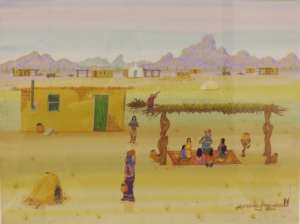
Tohono O’odham Village
Michael Chiago
gouache on illustration board
Commissioned with funding from the Tucson/Pima Arts Council
ACNO 2003.2.2
The Tohono O’odham have made their homes in the Sonoran Desert for generations. They learned to live in the desert, to be members of its unique natural community, to harvest wild foods and farm arid land. On a typical summer day, people are at work and at play while a storyteller sits in the shade of a ramada, with children gathered around to listen. Baboquivari Peak, sacred to the Tohono O’odham, is visible in the distance.
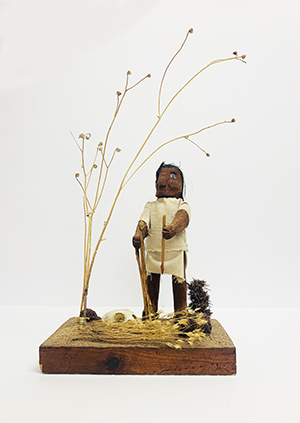
The Hunter
Thomas Franco
carved saguaro rib, fabric, leather strips, human hair, dirt, rocks, plants, and an animal skull with paints and stains
Gift from the Collection of Martha and Frank Secan
ACNO 2004.3.2
A man stands holding bow in one hand and arrow in the other in a desert scene complete with plants and an animal skull.
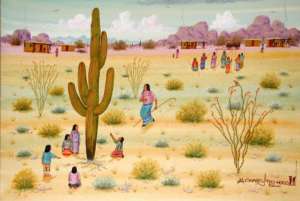
Origin of the Saguaro
Michael Chiago
gouache on illustration board
Commissioned with funding from the Tucson/Pima Arts Council
ACNO 2003.2.3
One Tohono O’odham creation story explains the origin of the saguaro thus: long ago, a young boy was left to grow up alone while his mother played toka, field hockey. One day the boy went to find his mother, traveling to many villages, crossing the mountains, asking animals for help along the way. When at last, he found her, she was too busy with her game to come to him. He stood in a tarantula hole and asked the village children to help him sing. With each song, the boy sank deeper into the ground. His mother, warned of her son’s fate, ran to him, but arrived too late. He was gone. As it happened, Coyote (Ban) was passing by and told the mother he would rescue her son. Instead, tricky Coyote ate the child and presented the mother with bare bones. From the spot where those bones were buried, the first saguaro grew.
From a very young age, Tohono O’odham children are taught that they must never harm a saguaro; they are reminded that saguaros are people too.
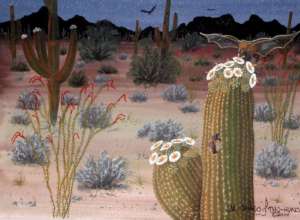
Desert at Night
Michael Chiago
gouache on illustration board
Commissioned with funding from the Tucson/Pima Arts Council
ACNO 2003.2.4
In May and June, the saguaro cactus blooms, promising fruit to come. At night, long-nosed bats feast on the blossom’s pollen and nectar, assisting in pollination, which is essential for fertilization and fruit production of the cactus. Gila woodpeckers’ nest in cavities hollowed out of saguaros.
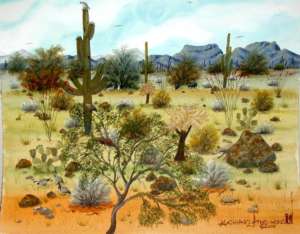
Pastoral Desert Scene
Michael Chiago
gouache on paper
Commissioned with funding from the Tucson/Pima Arts Council
ACNO 2003.2.1
In early summer, the desert bakes in the hot, dry sun. Many animals have adapted to this harsh environment; some creatures seek relief from the heat of the day in the shade of trees. Saguaro flowers bloom and everyone hopes that rain will come soon.
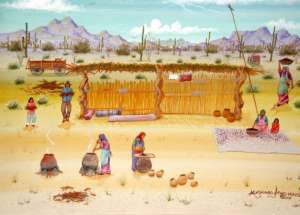
Saguaro Camp
Michael Chiago
gouache on illustration board
Commissioned with funding from the Tucson/Pima Arts Council
ACNO 2003.2.6
Year after year, Tohono O’odham families return to the same sites, where saguaros are plentiful. Some Tohono O’odham families still spend several days or weeks in saguaro camps, while others go on weekends, as their work schedules permit. Just as their ancestors did, they build ramada’s for shade, using mesquite or palo verde for framing and ocotillo, brush, or saguaro ribs for roofing. They may also use modern materials such as lumber and tarpaper. Ramada’s may shelter tables and chairs for socializing because the saguaro camp is a time for visiting with family and friends, as well as a time of hard work.

Man with Shield and Woman with Carrying Basket
Domingo and Chepa Franco
carved saguaro rib, cholla, fabric, human hair, wool, yarn, and canvas with paint and stains
Gift of Joan E. Donnelly and David Taylor
ACNO 2005.3.2
A husband leads the way on this couple’s journey. He holds a shield in one hand and a drum beater and rattle or war club in the other. His wife carries her belongings in a carrying basket on her back and uses a walking stick. Her basket is filled with natural fibers, a roll of cloth representing a bed roll, a shallow wood tray and hollow tree trunk.
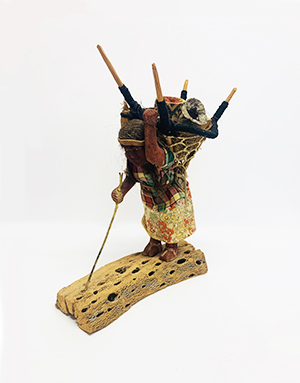
Woman With Burden Basket
Domingo and Chepa Franco
carved saguaro rib, wood, fabric, human hair, saguaro boot, natural fiber and yarn with paints and stains
Gift of Vicki and Neil Donkersley
ACNO 2004.2.1
A woman carries a load on her back in a large carrying basket. One arm steadies the basket while, in the other hand, she holds a forked walking stick. The basket contains fiber, a miniature pot made from a saguaro boot, a wood basket and a shallow wooden mixing bowl. Hanging from the basket near the woman’s head is a wooden water jug. A head strap helps the woman carry the load.
Women carried firewood, pottery and other belongings with a carrying basket. The basket was typically made of long saguaro ribs connected with an open-weave netting made of twisted agave fibers. A head strap and back pad were made using plaited sotol fibers.
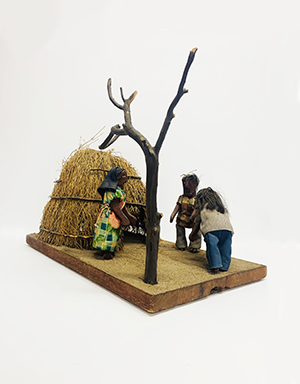
Tohono O’odham Family Outside their Brush Home
Chepa and Thomas Franco
wood, cardboard, fabric, human hair, sticks and brush
Gift of Joan Donnelly and David Taylor
2008.6.1
Three figures, two male and one female, standing outside a round, brush structure. A stick stands in the back left corner, representing a tree. The one-inch wood base is covered with dirt, small gravel and brush debris. Male figures stand to the left of brush home opening and woman stands to the right. All three figures are extending their arms and one is bent over, indicating the figure was meant to perform a task of some kind.
Because of their lifestyle, their houses needed to be of easy construction while providing the necessary shelter. The Tohono O’odham call their house structures “kis” and they made a round thatched home from a sturdy foundation of either saguaro ribs, ocotillo, or mesquite branches covered in grasses and brush. Each house included an eastern-facing entry door, small enough to crawl through, and a central fire pit. Cactus, plants, and rocks were removed and the dirt-packed floors were either left otherwise unmodified or covered with plaited yucca mats. Most often, the dwelling was built during the summer months and the family built a ramada structure nearby.
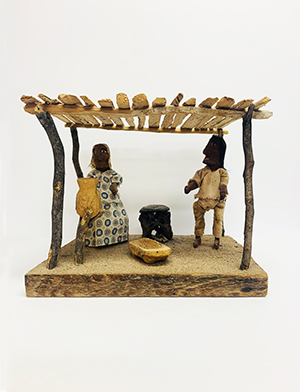
Tohono O’odham Couple under a Ramada
Mr. and Mrs. Thomas Franco
carved saguaro ribs with cholla, wood, cloth, and human hair on a wooden sand covered base
Gift from the Collection of Linda and Peter Friedman
ACNO 2016.1.1
A couple under a ramada made of saguaro ribs with a cooking stove made from cholla skeleton behind them. There is a mortar on the ground and a jug, possible representing the saguaro harvest.
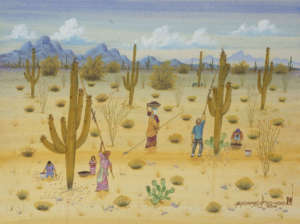
Saguaro Harvest
Michael Chiago
gouache on illustration board
Commissioned with funding from the Tucson/Pima Arts Council
ACNO 2003.2.5
Early summer’s saguaro fruit month is the first month of the Tohono O’odham year. Roughly equivalent to late June and early July, this is when the saguaro fruit ripens to scarlet red. A Tohono O’odham man and woman harvest ripe saguaro fruit using saguaro rib harvesting poles. Women with willow baskets carry and sort fruit and, on the ground, children gather and sample the fruit. The first step in preserving the annual harvest is to split open the fruit that is not open already and scoop the pulp and seeds into a bucket while many temptingly sweet and crunchy fruits are eaten on the spot. During the last harvest of the season, the emptied husks are placed on the ground with their red interiors turned toward the sky to hasten the rains.
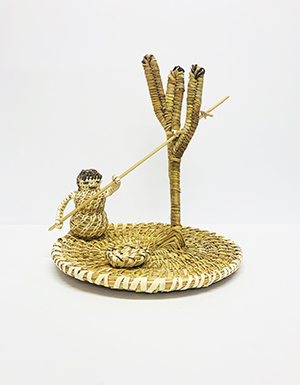
Saguaro Harvester
Della Cruz
yucca, beargrass, devil’s claw and yucca root
Gift of Vicki and Neil Donkersley
ACNO 2006.3.1
This sculpture depicts a person in the act of saguaro harvesting. There is a basket on the base for the fruit, and the figure holds a large stick to pluck the fruit. The first step in preserving the annual harvest is to split open the fruit that is not open already and scoop the pulp and seeds into a bucket while many temptingly sweet and crunchy fruits are eaten on the spot. During the last harvest of the season, the emptied husks are placed on the ground with their red interiors turned toward the sky to hasten the rains.
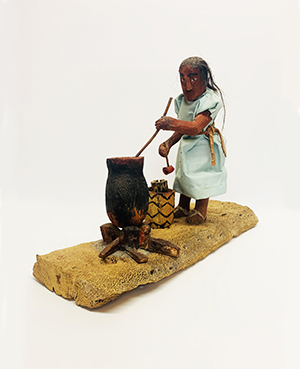
Woman Making Saguaro Jam
Domingo and Chepa Franco
carved saguaro rib, fabric dress, leather belt, cholla and human hair with paints and stains
Gift of Joan E. Donnelly and David Taylor
ACNO 2005.3.1
A woman is making jam from red-ripened fruit of the saguaro. She has a pot placed over an outdoor campfire to boiling the mixture. The woman has a dipper and wire utensil that she uses to stir or skim the mixture. Two baskets, one on top of another, are at her feet with the top basket being a sieve to filter the pulpy fruit from the liquid that drains into the bottom basket. The Franco’s cleverly used a natural piece of cholla to represent the sifting basket.
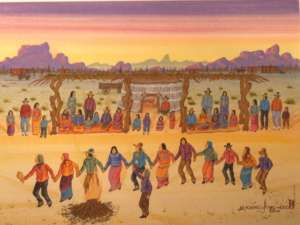
Wine Ceremony
Michael Chiago
gouache on illustration board
Commissioned with funding from the Tucson/Pima Arts Council
ACNO 2003.2.7
I’itoi, the creator of the Tohono O’odham, taught the Desert People their sacred wine ceremony so they could summon the rain. He taught them to make saguaro wine and gather to drink the wine and sing important songs to sing down the rain. For two nights, villagers dance in a circle outside of the Rain House where the saguaro wine ferments. The chief singers sing and make music with gourd rattles. The medicine man, in the center, holds eagle feathers to catch the wind to will the clouds in, bringing rain. Once the wine is ready, people sit in a circle and sing stories about how the wine makes the rains come and pass the wine baskets around, drinking until it is gone.
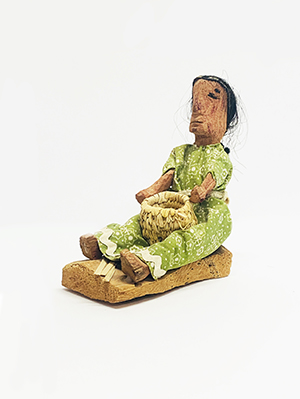
Basket Weaver
Chepa Franco
carved saguaro rib, fabric, human hair; miniature basket; paints and stains
Gift from the Collection of Martha and Frank Secan
ACNO 2004.3.1
A woman is seated and holding a coiled Tohono O’odham basket. She wears a green cotton dress and human hair tied with fabric thong. Several loose fibers of yucca lie near her feet.
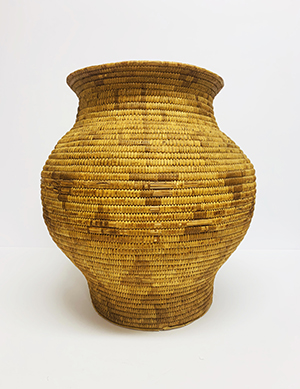
Unknown Tohono O’odham Artist
Coiled Storage Jar
beargrass with white and green yucca
Gift of the Estate of Agnes T. and Don L. Smith
98.1.46
Coiled Tohono O’odham storage jar with a round body and a flat base. The jar has a stacked triangle design on the body with saguaro design at neck and shoulder of jar.
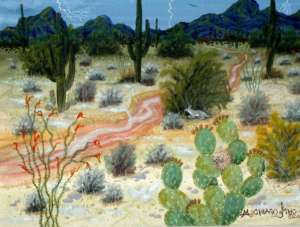
Monsoon Rainstorm
Michael Chiago
gouache on illustration board
Commissioned with funding from the Tucson/Pima Arts Council
ACNO 2003.2.8
As a result of a successful wine ceremony, the summer rain arrives and washes through the desert. The sky is dark, lightning flashes, and animals seek cover. The monsoon season provides young and mature saguaros an opportunity to replenish their stores of water.
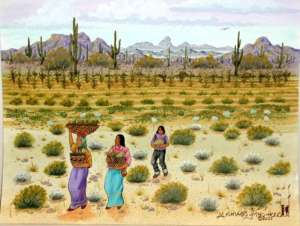
Vegetable Harvest
Michael Chiago
gouache on illustration board
Commissioned with funding from the Tucson/Pima Arts Council
ACNO 2003.2.9
Two women and a boy carry beautiful baskets full of corn, squash, melons and devil’s claw, the bounty of cultivated foods that came as a result of summer rains. Summer rain brings the harvest season for the tepary beans, squash and corn. Traditional Tohono O’odham fields were located at the mouths of arroyos where floodwaters deposited fertile silt from the foothills and mountains. Crops were planted in soil made rich by previous seasons of flooding and were irrigated with water from the current season’s rainfall. The Tohono O’odham honored the desert’s rhythms and the desert rewarded their wisdom and hard work with successful harvests. Tohono O’odham farmers grew devil’s claw for making baskets, including those used in the saguaro wine ceremony to summon rain back to the desert year after year.
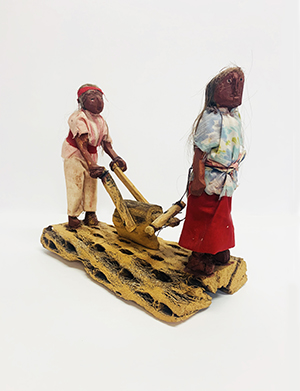
Woman and Man Plowing their Fields
Chepa Franco
carved saguaro rib, fabric clothes, and human hair with stains and paint
Gift of Linda and Peter Friedman
ACNO 2006.2.1
Working together, a couple plows their fields. The woman wears a harness around her waist and pulls the plow while her husband pushes in back, making the furrows to plant their crops.
In the past, the Tohono O’odham farmed their desert lands by using seasonal rainfall and diverting water from rivers and washes. Their traditional crops of tepary beans, squash, corn and melons provided a bountiful harvest coupled with the desert’s wild natural foods including cholla buds, mesquite beans, and prickly pear and saguaro fruit.
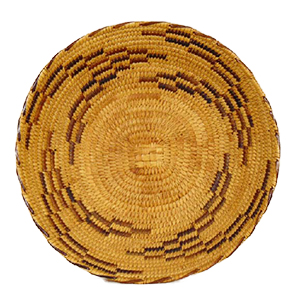
Coiled Tray
Unknown Tohono O’odham Artist
beargrass with bleached yucca and devil’s claw
ACNO 98.1.6
Coiled tray with four revolving seedpod designs.

Woman Grinding Mesquite Beans
Domingo and Chepa Franco
carved saguaro rib, wood, fabric and human hair with paints and stains
Gift of Joan E. Donnelly and David Taylor
ACNO 2004.1.1
A woman grinds dried mesquite beans using a natural stone mortar and a tapered cylindrical pestle. A basket for mesquite flour sits on top of the mortar with another basket storing mesquite beans set at her feet. A woman might spend a whole day gathering and grinding enough mesquite beans to feed one person for five days. Mesquite beans make slightly sweet-tasting flour that is high in calcium, iron and zinc.
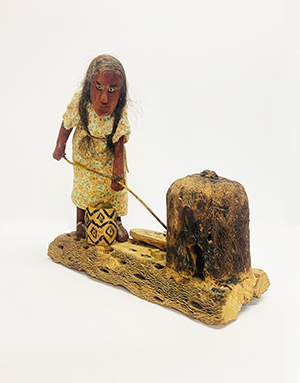
Woman Baking Bread in an Outdoor Oven
Domingo and Chepa Franco
carved saguaro rib, wood, fabric, human hair and cholla with paints and stains
Gift of Joan E. Donnelly and David Taylor
ACNO 2004.1.2
A woman is making bread for a feast, the Wine Ceremony, an anniversary, a wedding, or a wake. The unshaped dough is in a dish to her left with the newly baked bread is raked from the oven and will be placed in the basket to her right.

Tohono O’odham Family Scene under Ramada
Mr. and Mrs. Thomas Franco
carved saguaro rib, wood, fabric, and human hair with paints and stains
Gift from the Collection of Martha and Frank Secan
ACNO 2004.3.3
A family of three performs traditional tasks under their ramada. The older woman is shelling mesquite beans to be ground into meal, the younger woman is putting a pot of beans on the fire, and the man is about to have a drink from the dipper near the clay water jar.
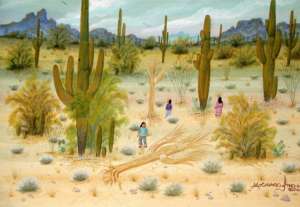
The Next Generation/
Saguaro Came Full Circle
Michael Chiago
gouache on illustration board
Commissioned with funding from the Tucson/Pima Arts Council
ACNO 2003.2.10
While saguaros die from many causes—including drought, disease, hungry animals, encroaching development, vandalism, lightening, wind, old age, and especially freezing temperatures, death does not end their role in the desert community. A variety of insects and other animals feed on and make their homes in decaying and fallen saguaros. People use dried saguaro ribs for building materials and tools, such as the Tohono O’odham’s cactus puller, and empty saguaro boots are perfect storage containers.
[/expand]

To receive regular updates of our exhibitions and receptions, subscribe below and when prompted, select the Exhibition Announcements & Receptions email list.
For Artists: To receive emails with exhibition opportunities including calls-for-entries, subscribe below and select the News and Opportunities for Artists email list.
